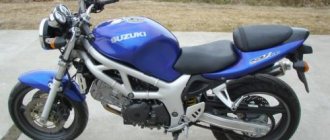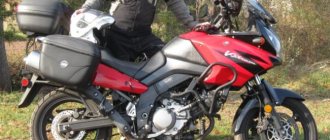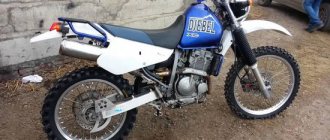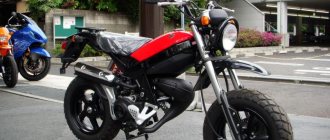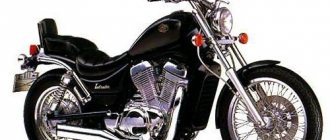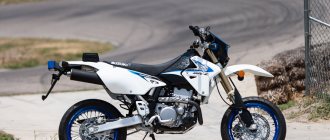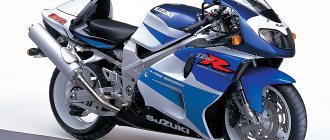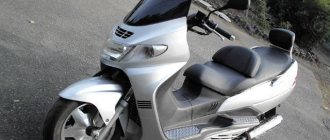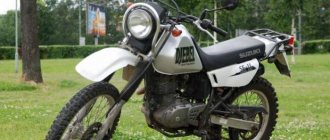Suzuki DL 650 V-strom
The big tourist is beautiful and comfortable, moderately powerful, but economical. For many, this is the dream bike.
Several modifications have been released based on it.
Being the younger brother of the DL 1000 , I received a number of parts from it, which had a positive effect on maintainability. SV650 model of the same brand can also be considered a relative .
The highlight of the motorcycle is that, being the lightest among its classmates, it is at the same time the most powerful .
When can we expect V-Strom in Russia?
The start of sales of the updated Suzuki DL650 V-Strom on the Russian market is scheduled for next year: the first “live” motorcycles will begin to appear in showrooms by the beginning of the next motorcycle season. Information on prices is still somewhat vague: it is only known that the new product will cost the same as the previous model. More accurate data will apparently be released closer to the start of sales.
But even if the new V-Storm turns out to be somewhat more expensive than its predecessor, Kolesa.Ru has no doubt about its success in Russia. Because a touring motorcycle that is not afraid of bad roads and broken dirt roads is exactly what we need for our endless expanses...
Specifications
The engine is a liquid-cooled 2-cylinder composite alloy block.
The engine is based on the model installed on the SV650. But, the new version received different camshafts , crankshaft and exhaust system . It was further reconfigured and traction was added throughout the entire range.
The main difference from the prototype was the cylinder block . Instead of cast iron, a composite alloy SCEM (Suzuki Composite Electro-chemical Material) was used for its production - our own patented invention. Thanks to this, the block becomes lighter, stronger, and less thermally conductive.
Since 2012, they began to install SDTV (Suzuki Dual Throttle Valve) - a dual throttle valve control system. The principle boils down to the fact that one is controlled by the throttle, the second by electronics, triggering when the engine reaches a certain speed.
In the SDTV system, each throttle cylinder has two throttle valves.
Otherwise, this is a standard 2-cylinder unit with an L-shaped ( V-shape tilted on its side ) pistons arrangement:
- working volume - 645 cm3;
- number of cylinders - 2;
- number of cycles - 4;
- number of valves - 8, 4 per cylinder;
- power - 63.5 hp (71);
- torque - 55 Nm (62);
- cooling - liquid;
- fuel supply - injector;
- ignition - transistor (TDI);
- start - electric starter;
- tank volume - 22 (20) l.
In the process of evolution, the power and torque have changed somewhat - the figures for the latest editions are in brackets.
Test drive Suzuki V-Strom 650
Suzuki V-STROM DL 650 2008/2011
Sooner or later, there always comes a time when the model being produced leaves the assembly line. A good option is when she is replaced by a successor and a bad option when she simply leaves forever. But now let’s look at the first of them, taking both “old” and “young” into a “comparative test”. Moreover, we will not care which of them looks better in appearance - we do not intend to pay more just to attract the attention of the weaker sex or loitering people.
This is a test purely on the usefulness and practicality of the popular mid-sized touring enduro in the old and updated version.
So, we have two “V-twins” with volumes of 650 “cubes”, which are closely related to each other. One of them is four years old, but the model has been in production since 2004, and the second was released last year after modernization, which included some technical and more visible cosmetic changes. We thought so too, but reality shows that judging a book by its cover is meaningless. The V-Strom DL650 has been and remains one of the most popular motorcycles in this class. How significant is the difference between these models and is it worth pursuing the new product?
Ergonomics
Sitting behind the wheel of the old model, you feel that everything is at hand, as if made to order. Every button, every switch is where our subconscious awaits. Personally, I'm a fan of the old dashboard, although it's a matter of taste. In addition, the new dashboard has an illegible tachometer, which is difficult to read both day and night. The locations of some warning lamps may also seem unusual to fans of the old V-Strom.
Comfort
The V-Strom should be comfortable anywhere, anytime. Let's start with the "sofa". Compared to the new product, the seat of the previous model is too hard... Although not as hard as the “perches” of sports motorcycles, the difference is quite significant. In general, ergonomics and comfort have been significantly improved - here, as they say, “neither give nor take.” The layout of the controls hints at a sportier style, but is still very comfortable. The knees are bent slightly less due to the lower pegs. Plus the aforementioned "sofa"... It was designed from the ground up and I'll bet the development was long and meticulous. This is cool. The soft and comfortable seat allows you to cover 600 km a day and still want to go further. The old model was very good in this regard, but when you feel the new saddle under your saddle, you realize that someone designed it especially for you.
Wind protection
Unusual... Because the new model uses a smaller windshield, which, oddly enough, increases comfort! In the old model, at high speeds, there was a very unpleasant flapping of the helmet by the turbulent flow coming off the glass. Now the head is surrounded by a uniform flow of wind and does not dangle from side to side.
Engines
There are changes here too. Most importantly, the engine in the new V-Strom has been improved to optimize traction control. Throttle response is softer, smoother, and you feel like the fuel injection system is working like a clock. It seems that the dynamics have weakened, but this is a deceptive impression. The motorcycle picks up speed just as quickly, and power and torque are evenly distributed throughout the entire rev range. Another interesting point is the subjective perception of speed of both models. The older model makes you feel like you're going faster than you actually are. You can find many explanations for this and try to see the reason in different things, but the facts speak for themselves. The new model is more docile and responsive, and consistently wins during acceleration competitions. The updated V-Strom knows how and loves to go fast. Of course, this is possible not without the assistance of the suspension, which allows you to feel the motorcycle perfectly at a decent cruising speed of 140-150 km/h.
Hardware
The gearboxes on both V-Stroms are flawless, shifting smoothly. If you correctly catch the engine speed, you can change gears quietly and smoothly even without a clutch. If we talk about the clutch, then on the 2011 model it works noticeably better. It is easier to feel the moment of contact between the discs, which simplifies the process of moving away.
Suspension
This is where things get complicated. The suspension of the old model was very good, and its versatility allowed the motorcycle to be used in almost any conditions, if you do not take into account extreme muddy conditions. It would seem that it is impossible to do even better... But the manufacturer seems to have succeeded, and the new model drove even better! Yes, you can find a suspension that handles bumps better, like the BMW F650GS, or one that handles rough asphalt at high speed better, like the Triumph Tiger 800. But with the Suzuki, you have a great compromise!
There's no reason to complain about the new V-Strom's suspension, especially since it matches its performance characteristics perfectly. Nothing feels extraordinary. It simply provides complete control over the entire motorcycle, which allows even a novice motorcyclist without much experience to be confident in his abilities.
For reasons that I have not been able to fully define and explain, the old model performs better off-road. Of course, when I say “off-road,” I mean dry forests without undergrowth and dense gravel embankments, not swamps and deep sands. The old V-Strom is more stable at low speeds and doesn't have some of the new model's nervousness at low revs. But if someone prefers to operate exclusively or mainly on asphalt roads, then the new model will not only not disappoint him, but will also surprise him with the handling refined by the standards of the class, feeling how pleasant it can be to write out long curves in turns.
Brakes
The “4-year-old” brakes very effectively and, in addition, has excellent engine braking (SV650 genes...). The new model takes some getting used to. The brakes of the new V-Strom are identical in operation, but differ in the presence of ABS (an option on the old model). It works perfectly, activating only when it is really necessary. You just can't turn it off.
Fuel consumption
Fuel consumption is almost the same on both models. But Suzuki said that the tank volume of the new product has been reduced from 22 to 20 liters for the benefit of lower curb weight and lower fuel consumption. I think that this was dictated by changes in design. It is safe to assume that the actual range of both motorcycles will be more than 400 km. At the same time, the developers of the new V-Strom claim that the motorcycle is capable of traveling 556 km without refueling. Sorry for the pun, but I didn’t have the courage to check it out - since going the entire distance at a constant speed of 70 km/h is too difficult a test for me personally.
The manufacturer failed to correct the “childhood disease” - inaccurate operation of the fuel level indicator. On the old model, its needle could show 100% fuel, then drop by 30% and remain at this level for many hours. The new model does basically the same thing, so if you suddenly see the reserve light flashing, you know you have at least 200 kilometers left.
100% success
The old V-Strom was a pretty sensible bike and didn't need an update. Nevertheless, it was decided to carry it out, and it had amazing consequences. We didn't think these two twins would be different. Usually, when a company restyles an already successful model, it can be quite boring. But not at this time.
The new model turned out to be better - that’s true, but the old one is still just as good, thanks to which it has “made nests” in thousands of garages since its introduction.
Brief summary
The latest V-Strom is a great bike. I don't think anything can be improved further. And even if it is possible, then what? Suzuki will now have to focus on big touring enduro to compete with the GS.
I can't say which model I would like to have. The new V-Strom has no flaws. This is a practical and reliable tool for moving in space. I've never ridden a motorcycle that handles so easily.
Both motorcycles are light, comfortable, dynamic, fun, economical and reliable. Whatever you choose, you will still be satisfied.
Text: Lukasz Tomanek
Adaptation: Sergey Kuznetsov
Photo: provided by the author
Driving performance
The flexibility of the suspension allows you to adjust the bike so that you can confidently take turns on the highway and on the ground without shaking your spine into your pants.
The maximum speed according to specifications is 185 km/h . According to users, 170 km/h is reached easily, then a lack of power is felt. You can dial 200, but many people think that the limiter is in the way. The developer denies the presence of this detail:
“What are the limitations on the export model? We didn’t plan it for domestic markets and didn’t set any restrictions.”
The dynamics of acceleration can be the envy of other sports. From zero to 100 km/h - 3.98 seconds .
Fuel consumption
- Fuel consumption for the extra-urban cycle is 4 liters .
- In the city up to 5 l .
Owners recommend preparing for 4.5 liters per 100 km .
Well, not even two years have passed since I am writing again on my favorite resource, and then - have a good time reading this post to everyone! It so happened that this season I switched from my old 650 Wistrom to a new 650 Wistrom and decided to keep a logbook where I would record my mileage for the season, maintenance, personal goals and observations. I ask about all this under cat. I’ll break the already small text into paragraphs so that everyone can skip what’s unnecessary and move on to the stage of interest: numbers, impressions, etc.
Owner (boring here):
It seems to me that a few words about your beloved self will give you an understanding of why everything turned out this way and not otherwise. Those who have come across my notes here know that from 2014 to 2022 I rode a Racer Ranger 200 - a beautifully polished Chinese enduro, then I got into the saddle of a 2009 Wistrom that shocked me, the turning point - thanks to him I realized , what interests me about these motorcycles of yours. So, exactly a year ago I decided that I wanted to update the equipment, because the mileage was approaching 70 thousand km, it was gradually losing its potential resale value, and after a couple of seasons large maintenance loomed - in short, I did the math and decided that I could take a risk: sell a good one motorcycle and have time to save up for another good motorcycle “ACHTUNG - USE THE METHOD WITH CAUTION.” In general, I set my sights on the next Wistrom. Dull, huh?) But I somehow fell in love with this model so much, I believed so much in its problem-free nature, in our similarity of characters, leisurelyness and rationality, that even the Tiger 800 and the gosling couldn’t lure me up a notch, it seems. Stromophilia is thriving, everything is clear with this man, fuck him.
Economy:
- Purchase: RUB 655,000;
- Insurance: RUB 1,700;
- Registration: 1650 rub.
I took out the policy from brokers, I could have done it myself, as it turned out, because I was given exactly the same e-OSAG as I wanted to do, I overpaid 500 rubles, so keep in mind for those who are just getting into this business.
Tuning:
- Arcs 11,500 RUR;
- Case 47 liters 8500 rub;
- Radiator protection RUB 1,700;
- Footrest extender RUB 1,200;
- Well, for the holidays we received a Scottoiler and a St. Petersburg spoiler for the windshield.
Note to the owner: a spoiler on the windshield is simply a great solution!
Yes, it hardly compares to the National Cycle glass on my old motorcycle, but still, I feel comfortable and can still enjoy riding with the visor open. Maintenance: It turned out that it was not convenient for me to drive a motorcycle to Moscow, so I decided to service my equipment myself, fortunately, in theory, I usually do simple procedures myself.
Mileage during the season is 7500 km.
TO1 — 1850 RUR (1078 km)
- Oil change, I use eni ridemoto 10w50;
- Replacing the filter, installed mann mw65;
- Pulling threaded connections with a dino wrench according to the manual. Everything is normal, except for a couple of muffler mounting bolts;
- Lubricate connections according to the manual.
TO 1.5 - 1000 rub (4700)
- Oil change, it's still the same;
- Adjusting the free play of the clutch handle is also according to the manual.
Yes, indeed, the next replacement should have been carried out at 6 tkm, but I decided to make another replacement, since running-in and all that, I don’t know whether they do it that way or not, but I thought it was right.
The next maintenance will be at the beginning of the 2022 season and will include changing the oil and filter, lubricating all the private parts indicated in the manual and, perhaps, that’s all! This will be a full-fledged TO2
Gasoline: ~ 330 liters of 95 ~ 15,700 rubles (I consider the average price to be 47.5 rubles).
A few words about consumption. Over the entire run this season, the on-board computer showed an average of 4.4 liters. Mileage 80 percent countryside and suburbs, a pinch of exits to lakes and a couple of trips for work. Well, it’s fair to say that I feel nauseous and don’t drive more than 120 km/h, a comfortable speed is exactly 110 - 120 km/h, only once I was in the mood for 130, I didn’t do traffic light races, because most often the outcome is clear)) Well, yes , a little less than half of the entire journey was done with a passenger and light cargo. In general, with a passenger on the highway, the computer shows up to 4.6 liters, which is fully confirmed by receipts, in one up to 4.3-4.4 l/hundred.
About emotions
You know, I've been in puppy squeak all season! What I wanted was my favorite Wistrom, but also a new one. He performs my tasks in reserve!
- Excellent straight landing, to which I will add spacers under the steering wheel just to have fun;
- I modified the wind protection a little with a spoiler on the glass: this was necessary in order to drive with the visor open and unhinderedly inhale the smells of pine forests and the fumes from under overtaken trucks - romance, in short;
- At the moment, I want to install a luggage system and, perhaps, get some side bags for the first time;
- The standard narrow hand protection played an amazing role - it incredibly removes cold air! But still, heated grips on long trips are a must-have, I think.
So far, nothing else comes to mind: everything has been collected for my asphalt-forest-lake use.
As a result we have:
- Motorcycle: RUB 655,000
- Service: 3060 RUR
- Legal matters: RUB 3,350 (insurance and registration)
- Tuning: Approximately 33,000 rubles, and in the future this figure will increase to “HOW MUCH????”
I'll probably end here. Thank you all, I hope this information is useful for comparison for someone. If so, then I went to bed an hour later - for good reason. May your dreams come true and open borders next season!
Weight
In 2011-12, the motorcycle received a major update, which affected both the filling and external parameters.
Curb weight changed from 207 to 214 kg .
Dry from 185 kg to 195 kg .
Motorcycles without stock ABS weighed ~20 kg less.
Dimensions
Currently, the model is one of the lightest among motorcycles of this class.
The sizes have changed several times:
- The length of the bike has become shorter - from 2290 mm to 2275 mm ;
- lost weight in width - from 840 mm to 835 mm ;
- grew in height - from 1390 mm to 1405 mm .
The wheelbase has also become larger - from 1540 mm to 1560 mm .
Seat height - from 820 mm to 835 mm .
Ground clearance - from 165 mm to 175 mm .
For whom is it intended?
One statement from the developers that this is an export version indicates that the biker cannot be short.
The optimal height for the owner of this motorcycle is from average and above.
However, even tall users ( above 180 cm ) note that the motorcycle is tall. “I stand on tiptoes at traffic lights.”
Technique: the best is the enemy of the good!
The first V-Strom entered the market almost 10 years ago: in 2003. Since then, the motorcycle has not undergone any radical changes, and, by and large, it doesn’t need it: the design of the model is not outdated at all. Therefore, Suzuki engineers, apparently guided by the “golden rule of mechanics” (not to repair something that already works well), left the basic elements of the frame and chassis unchanged.
However, they did modernize some things. For example, the weight of the motorcycle was reduced by 6 kg. The engine design also remains the same (it is a 645 cc four-stroke V-Twin with a cylinder angle of 90 degrees), but its performance at low and medium speeds has improved. In addition, the engine has become more economical.
At the heart of the V-Storm is still an aluminum frame. The pendulum arm is also made of light alloys. ABS is now standard equipment on all versions of the motorcycle. The updated V-Strom is offered in three color options: Pearl White, Gloss Black and Metallic Orange.
Modifications
There are two official modifications for the motorcycle. The first one appeared in 2007. Stock ABS appeared on the bike . The modification was called Suzuki V-Strom DL650A. It was marked by the transition to 2 spark plugs per cylinder (previously there was one, according to tradition).
Suzuki V-Strom 650 XT
The V-Strom 650 XT modification featured spoked wheels and a front beak.
The second modification was born in 2015 .
- The main differences were the spoked wheels and the predatory “beak” that some pit bikes have.
- But they also began to install a digital instrument panel on the model, although the tachometer on it remained a cup-shaped, analogue one.
- In addition to speed, the gear indicator, fuel level, and mileage meter have become digital.
In 2022, the model changes again, although it is not called a separate modification. The appearance of the new development almost completely repeated its aging brother - the liter motorcycle.
Design: classic and modern
The changes that occurred in the appearance of the model could be called “cosmetic” if they did not pursue an exclusively practical goal: to improve the protection of riders from the wind. It is for this reason that Suzuki designers completely redesigned the plastic “body kit” in the front and side of the motorcycle. As a result, the profile of the “650th” V-Strom began to resemble the classic models of the company.
The belonging of the new product to the modern line is indicated by alloy wheels, as well as an upward-facing muffler with a chrome trim. The most striking differences from its predecessor (besides the plastic) are the new shapes of the seat and gas tank.
Competitors
The first Japanese who comes to mind in the touring-enduro class is, of course, Yamaha with its Tenere.
Yamaha XTZ 660
The Yamaha XTZ 660 is a good choice for those who are interested in an inexpensive touring motorcycle.
XTZ 660 launched in 1991 , XT 660 Z - conceived as an update to the line, was released already in 2007 . Compared to Suzuki, they had 1-cylinder engines and a 5-speed gearbox. Because of this, they lost in terms of dynamics and maximum speed.
Honda XL700V Transalp
Honda was not far behind. Its XL700V Transalp was released in 2008.
The model was produced up to and including 2011, mainly for the European market.
It had a V-shaped engine with 2 cylinders , a 5-speed gearbox , a speed comparable to Suzuki, but at the same time it lost in dynamics . It’s interesting that the brand also has a 650cc model, but only the older model was offered for comparison.
Kawasaki Versys 650
Kawasaki Versys 650 is one of the leaders in all-purpose touring motorcycles.
Kawasaki came closest to Suzuki.
The 650cc Versys model also has 2 cylinders (in-line), 6-speed gearbox , chain drive , and comparable speed. But it differs in three stock configuration options. From minimal - protection of hands, tank, side cases to luxury , in which an additional case is installed in the back, fog lights with LEDs, a second 12 V .
Peculiarities
Among the features of the motorcycle are:
- adjustable suspension (if competitors took length, then Suzuki used adjustments);
Front fork – adjustable spring preload.
Rear shock absorber – adjustable preload and rebound damping.
- aluminum frame (of course less weight, but strength? Competitors have it made of steel);
- separating into separate modifications parts offered by competitors in stock.
- 71 horsepower (in latest developments)
Some users also call weight. But for the above competitors it is either comparable or even less.
Flaws
To make the bike even better, it's worth installing the optional crankcase guard, otherwise the open engine will quickly turn into a lump of dirt.
- Users do not note any significant disadvantages except for one thing – love for butter . 0.5 liters per 1,000 km are noted . Some owners say that they need to fill in 10w/50 or 15w/50 instead of the standard 10w40 or less.
- They write about the falsity of moving at low speeds - but this depends more on the driver, and not on the motorcycle.
- Vibrations . Despite the 2 cylinders, they are there. They don’t interfere with movement, nothing is transferred to the handles/mirrors/pegs, but the bolts need to be tightened periodically.
Some people note the weight, but for a good off-road bike this is more a plus than a minus
Advantages
Users note:
- Convenience.
- Large windshield. Reliable protection from wind and rain at any speed from 100 to 180.
Despite the impressive size of the windshield, tall owners install an additional deflector so that the air flow passes over the helmet.
- Reliability.
- Affordable price (for some reason it is compared with the German “geese”, BMW R 750GS, BMW F 750GS).
- Accessories . Being essentially a hybrid between the liter DL 1000 and the naked SV 650 , it can use repair kits from both.
Sometimes they add design, ABS, good tires and long suspension travel.
